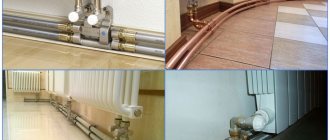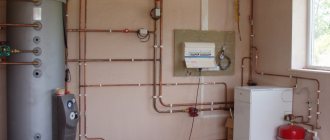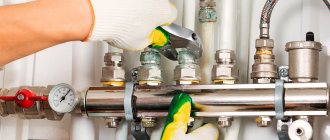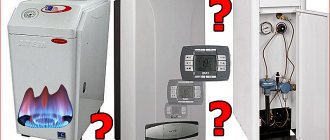An individual garage is an ideal option not only for storing a car, but also for carrying out necessary repairs in case of any problems. And if in the summer this should not cause any difficulties: it is warm and light, then when preparing for winter, you should think carefully about how to maintain a positive temperature inside. One of the best options to achieve this goal would be hydronic heating in the garage. Its installation can be ordered from specialists, or you can do it yourself. There is nothing particularly complicated about this.
Features of water heating in the garage
The difficulty of a warm hangar lies in its inconsistent operation. If the heating is turned off for a long time, the circuit may break due to freezing of water in the pipes.
The main feature of water heating in a room is to warm it up to a temperature of + 5-8 0C. This will provide the necessary warm-up to the car and prevent the development of metal corrosion.
Advice! Filling water heating pipes with antifreeze will prevent rupture of system elements when the garage is not constantly heated.
The scheme includes:
- boiler;
- radiators;
- line for supplying hot water and discharging cooled water.
The boiler's job is to heat the water that moves through the pipes to the heating radiators. The cooled liquid is returned to the boiler in reverse and the circuit is cycled.
System installation
Everything has been calculated, all the necessary components have been purchased, the tools have been prepared. Now the question arises: how to do it correctly and efficiently? The work algorithm is as follows:
- The first step is to choose places to place the boiler and radiators.
- We install the boiler.
- We hang the radiators in their places using reinforced dowels.
- We install a pipe system between the boiler and radiators.
- We connect the expansion tank.
- We fill the system with water.
It is possible and even necessary to heat the system. This will help you quickly identify all the shortcomings and eliminate them.
Pros and cons of heating a garage with water
A warm room for a car saves it from corrosion, peeling paint, and freezing of lubricant. Heating a garage with a water circuit creates optimal storage conditions.
Experts often dispute the advantages and disadvantages of a warm room for a car. There is an opinion that in a heated garage in winter, snow accumulates on the bottom and walls, and when it melts it causes corrosive changes in the metal.
In any case, in a heated room, it is more comfortable for the car owner to carry out maintenance and repairs on a friend on wheels. Some car owners turn on the heating only during repair work, and the car itself is stored in an unheated room.
Knowing the advantages and disadvantages, the car owner independently decides how to store his car.
What should be considered at the preparation stage?
A garage made of metal, brick, concrete or sandwich panels is a structure with high heat loss. If you do not provide reliable thermal insulation , then you will be heating the street. It is best to arrange external insulation of the garage, but if this is not possible, then you can get by with internal insulation. Not only walls, but also gates and floors need thermal insulation.
The heating system must be safe . A lot of flammable liquids and objects are stored in the garage, so the organization of heating must be taken with full responsibility:
- at the planning stage , make a diagram of the garage , on it you need to mark the storage location of fuels and lubricants. This warehouse should be located as far as possible from the heating device and located at some elevation. The plan also marks the place where the pipe exits through the ceiling or wall, unless, of course, the selected heating system provides for the organization of a chimney. It is also worth noting wooden surfaces near heating equipment - they are covered with sheets of galvanized steel. Don't forget to make room for a fire extinguisher. If a system using flammable fuel is chosen, it would be a good idea to provide space for a box with asbestos fabric;
- the floor and walls near the heating device should not be flammable;
- the heating system must not be left unattended;
- electrical wiring must be grounded;
- it is important to provide reliable ventilation so as not to become another victim of carbon monoxide poisoning;
- It’s better not to store all the junk in the garage that doesn’t have a place at home - it’s these things that become food for fire;
- It is better to smoke outside or, at least, as far as possible from heating appliances;
- electrical systems are not suitable for damp areas;
- It wouldn’t hurt to install simple smoke detectors to protect your own property and neighbors’ garages.
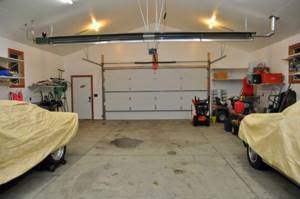
Water heating schemes in the garage
At the design stage of the circuit, the diameter of the pipes is determined. The higher its value, the more efficient the heating will be.
The thermostat increases or decreases the supply of hot water depending on the area of the heated room
Next, calculate the required number of radiators to warm the room. At the design stage, approximate fuel costs are determined. The choice is made on a cheaper and more accessible form of energy.
There are 2 types of heating systems: one-pipe and two-pipe
The water heating circuit consists of a boiler, pipes and radiators.
Red pipes – supply line, blue – return line
The water heated in the boiler flows through pipes into the heating radiators, the metal warms up, transferring heat to the air, which heats the room. The water cooled in the radiators is returned through the pipes to the boiler and heated. It's a continuous cycle.
Water heating is the most economical for heating a garage
In a private house, it is possible to combine the heating system of the garage and the house into one circuit by installing a switch that turns off the heating in the garage. This type is the most budget-friendly
The supply and return lines are located at a slope
Experts recommend installing a unified heating system in cases where the garage is located from the house at a distance not exceeding 40 m.
The heating system of the 2nd floor of the room on which the workshop is located provides for a sequential arrangement of radiators
The gravity scheme includes:
- expansion tank;
- boiler;
- main pipes;
- radiators.
In a gravity system, water is supplied to the radiators through risers. For the garage, it is advisable to install autonomous heating if it is remote from the house, in which case the costs of materials increase. Instead of radiators for heating the garage, you can use pipes with a diameter of 5 to 10 cm. In the hangar, you can install a heated floor, having equipped it with a switch. Complex heating is being installed in a garage cooperative.
Project

Before you go to a hardware store and buy all the components of the heating system, you need to draw up at least a schematic design. And the main emphasis in these calculations is on the diameter of the pipes that you are going to use. The trick here is that the larger the diameter, the greater the heat transfer. But at the same time, it leads to the fact that electricity will cost you a pretty penny if your system runs on electricity. Finding the optimal balance of both is the main design task.
Methods for water heating of a garage
The choice of fuel significantly influences the heating scheme in the room. The frequency of operation of the circuit should be taken into account. If the garage is located far from the house and is not heated daily, then during severe frosts the pipes and radiator may rupture. At the design stage, you should carefully consider the type of boiler and type of fuel.
There are several types of fuel:
- gas;
- solid fuel (coal, firewood);
- liquid fuel (used technical oil);
- electricity.
Attention! Solid and liquid fuels require additional storage facilities for storage.
The choice is made based on the cost of fuel and autonomy.
Water heating in a garage without electricity
The most common fuel in the private sector is gas. The advantage of this type is its low cost and availability. Gas heating does not require constant monitoring. With an uninterrupted gas supply, continuous heating is ensured.
However, if the gas pipeline does not pass through the area in which the building is located, they choose a different type of fuel, since it is very expensive to install a gas line.
A gas boiler for autonomous heating is not a cheap pleasure, especially when it comes to heating a garage
Liquid fuel is a low-budget type. The big disadvantage of this heating option is the need for a place to store used oil. You will need a large number of barrels or canisters and a place where you can store all the supplies. This is a fire hazard.
If you have a boiler for liquid fuel, you must constantly monitor its filling level, so you will have to visit the garage often to prevent the heating pipes from bursting
A solid fuel boiler will help you set up water heating in your garage using wood, coal, garbage or pressed briquettes. This option is suitable if the owner can visit the hangar every day and throw a portion into the firebox. After all, in the garage it is enough to ensure a positive temperature; there is no need to warm up the room too much. If a new portion of fuel is not added in a timely manner, the system may freeze and the pipes may burst.
A solid fuel boiler requires a constant portion of fuel, otherwise the system will cool down
For the hangar, you can install water heating using a potbelly stove. This oven is designed for a room up to 30 m2.
Water heating in the garage from electricity
An electric boiler is the most optimal option for a water heating scheme in a room. There is no need for an additional pipeline or storage area to store fuel.
An electric boiler provides reliability and comfort and does not require additional installation of a chimney or supply
Advantages of an electric boiler:
- compactness;
- reliability;
- does not require installation of a supply line;
- does not require the construction of a chimney;
- the device is equipped with a safety system: in case of overheating, the system will turn off;
- can operate on battery power during an emergency shutdown;
- In the event of an emergency power outage, the boiler will start working on its own.
Despite the high cost of electricity, the choice of this heating scheme is optimal, since it is enough to warm the air in the room to positive temperatures, and little fuel is required.
Mobile heat sources
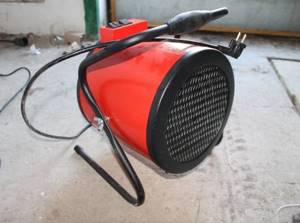
These include various electric heaters and heat guns. They are compact, do not take up much space and can be hung on the wall or installed on the floor. Be aware of high power consumption. Therefore, when using them, you should take into account the loads that the network will withstand. A heat gun will require a three-phase network or a wire with a large cross-section. The heater can also operate on gas, but using cylinders in a small garage is unsafe.
Infrared devices for heating a garage with electricity transfer heat to all surfaces of the room. Heated objects will also radiate heat. This is safe for humans, but can negatively affect the car's paint. Therefore, it is better to direct this flow to the garage door. You can do this method of economical garage heating with your own hands by studying the step-by-step instructions.
Convectors heat up themselves and give off heat easily. When turned off, they do not cool down for a long time.
If your budget allows, buy an inverter split system to heat your garage. The air conditioner can operate at temperatures down to -20 degrees. This type of garage heating will save energy and maintain a constant temperature.
Types of water heating garage
Water heating in a garage without a pump can be achieved using a gravity heating system.
There are 2 schemes:
- single-pipe;
- two-pipe.
Single-pipe water heating in the garage
Water heating in the garage from the stove is equipped using a single-pipe scheme. This scheme ensures the sequential passage of coolant through the radiators and return to the boiler.
A single-pipe heating system is easy to install and does not provide uniform heating of radiators
A significant disadvantage of the single-pipe scheme is the uneven distribution of heat. The first radiators will be significantly warmer than the last ones. Experts say that this problem is acute in multi-story buildings and less noticeable in single-story buildings.
Two-pipe water heating in the garage
In a hangar with a large area, experts recommend installing water heating using a two-pipe system. The first pipe pumps heated coolant to the radiators. The second drains waste fluid from the batteries back into the boiler.
The two-pipe system ensures uniform distribution of coolant throughout all radiators
The temperature of the radiators will be uniform, which will ensure uniform heating of the air. The disadvantage of this scheme is complex installation and a large number of pipes and shut-off elements, which increases its cost.
Choosing a connection method
In the garage you will be able to implement several heating connection schemes with your own hands:
- One pipe;
- Two pipes;
- Combination.
For a small room, a single-pipe design is also suitable; this will save time, effort and materials without compromising work efficiency. However, in large rooms it is better to use two pipes.
If we talk about the type of coolant, then ordinary water should not be used - the risk of freezing is too great, and ice will simply rupture the pipes from the inside, restoring the system will require huge financial investments. The best option is a specialized antifreeze that does not pose a danger to pipes and has an extremely low crystallization temperature.
How to make water heating in a garage
Arranging water heating from a potbelly stove in the garage is advisable if the area does not exceed 30 m2.
To install the system you will need:
- oven or boiler;
- cast iron radiators;
- metal pipes with a diameter of 5-10 cm for arranging the main line;
- locks, screws, fasteners.
The number of radiators and sections in them is determined based on the heated area of the building and the expected fuel consumption. Standard formula: 1 equals 100 watts. Calculations for 20 m2: 100*20=2000 W. The package indicates the heat transfer index of 1 section, for example, for cast iron - 120 W. 2000/120= 16.67 sections. This formula is used to heat a living room. It is not necessary to warm up the garage to a temperature of 20 0C, so experts advise dividing all calculations by 2. For a room of 20 m2, 16.67/2 = 8.33 sections will be required. The value is rounded up or down.
Attention! The diameter of the pipe affects the heat transfer. The higher the value, the more efficient the heating of the room and the lower the fuel costs.
During the installation process, metal pipes are assembled into the system using a welding machine, and plastic pipes using a soldering iron. For natural circulation of the coolant, the pipes are placed at a slope.
The water heating circuit assumes the presence of an expansion tank. It is made from a canister or other plastic or metal container. In the upper part of the tank there is a hole for adding coolant, as the liquid heats up and evaporates.
The boiler is installed in a permanent place and pipes are supplied
Install the boiler. Pipes and, if necessary, a chimney are connected to it.
The boiler is installed in a permanent place and pipes are supplied
Radiators are hung on fasteners, evenly distributed around the perimeter of the room. The distance from the floor is at least 15 cm. A gap of 5 cm is left between the wall and the battery.
Radiators are hung from the wall and main pipes are supplied
Using main pipes, the entire structure is connected into a single circuit. When welding or soldering pipes, experts recommend paying attention to the quality of the seams. The circuit is filled with coolant and turned on for testing.
Boiler selection
Currently, you can use the following electric boilers for heating a garage:
We immediately dismiss induction models due to their high cost. But this does not mean at all that they cannot be placed in the garage if anyone has such a desire if they have the means - there are no warnings. But with electrode boilers it’s worse; they may turn out to be ineffective when working with antifreeze.
Tip: When choosing an electrode boiler for your garage, find out how it interacts with the anti-freeze system. Some manufacturers, for example, GALAN, offer special antifreeze compatible with their products.
A regular heating element boiler is best suited for installation in a box. True, it is more expensive than the electrode one, but it is reliable and has no contraindications to antifreeze liquid. You just need to choose the right power of the unit; to do this, first measure the volume of the garage, and then multiply the result by 0.035 kW. You can take the simplest and most inexpensive model, without unnecessary functions used in a residential building.
General requirements
In the case of installing a heating system with your own hands, the property owner can personally choose the timing and need to turn it on.
Most often, the heating is turned on during repair work, and turned off while the car is being stored.
Safety
One of the main requirements for garage heating is its safety. The room contains a large amount of fuels and lubricants, as well as highly flammable items.
In cooperatives where structures are located end to end, a fire in a separate area can lead to the burning out of a significant area. For this reason, all heating systems must be capable of emergency shutdown in the event of an emergency.
Feasibility
For property owners, the economic feasibility of the methods used is important. If the installed heating system requires significant operating costs, you should think about choosing a different method.
Proper garage heating should be reliable and resistant to temperature changes outside the room. This also applies to energy supply interruptions.
The garage heating scheme involves preliminary thermal insulation of the room. Heating unprotected buildings is pointless - the heated air will escape through the cracks of the enclosing structures.
If no insulation measures are taken, no matter how high-quality the system is, it will not heat the garage, but the space around it.
How to reduce heat loss and not go broke?
No heating system will be profitable and efficient if care is not taken to reduce heat loss. Heaters will waste a huge amount of energy resources. This is expensive and impractical, so you will have to insulate the gates, walls, floor and roof.
You can use expanded clay, polystyrene concrete, foil insulation, but the cheapest and most versatile option is polystyrene foam. It is suitable for insulating all structural elements.
It can also be used for thermal insulation of the floor, provided that a floating screed is made: polystyrene foam does not tolerate mechanical stress well, so it is filled with cement.
The ceiling, walls and garage doors are covered with polystyrene foam. There are two options - external or external wall decoration. Both are equally effective and allow for excellent thermal insulation of the building. The choice should be based on the convenience of the garage owner himself.
More information about the coolant and its properties
There is no liquid that is ideal for any heating system. Each of the options presented on the coolant market has specific characteristics, for example, operating temperature range.
If you violate the boundaries of the specified range, the heating system will simply “stop”, and in the worst case scenario, pipes will burst and expensive equipment will fail.
In addition to temperature parameters, pipeline fluid has properties such as viscosity, anti-corrosion, and the ability to release toxic substances. An analysis of the required qualities showed that the best liquid coolants are purified water and a special chemical solution - antifreeze.
The table shows the main advantage of ethylene glycol-based antifreeze - the maximum freezing point is -40ºС, while water turns into ice already at 0ºС
Filling with antifreeze is necessary in houses that are not a permanent place of residence. Usually, when leaving a building during the cold season, owners drain the water to avoid accidents and equipment breakdown. There is no need to remove antifreeze - upon return, you can immediately turn on the boiler without fear of leakage or rupture.
At extreme temperatures, the chemical coolant, having changed its structure, retains its original dimensions. Simply put, it turns into a gel that retains its properties unchanged. When the temperature reaches a comfortable level, the gel-like structure becomes liquid again, completely retaining its original volume.
Some more useful information about antifreeze:
- lasts at least 5 years, one fill can withstand 10 heating seasons;
- fluidity is 2 times higher than that of water, therefore, it is necessary to monitor the tightness of the connections;
- increased viscosity requires the installation of a more powerful circulation pump;
- the ability to expand when heated entails the installation of a volumetric expansion tank.
And you must always remember that the chemical solution is toxic and dangerous to human health.
Antifreeze for filling into home heating systems is sold in plastic canisters with a volume of 10 liters to 60 liters. The average cost is from 750 to 1100 rubles. for 10 l
Despite the outstanding characteristics of antifreeze, water is more popular as a coolant. It has the highest possible heat capacity, which is approximately 1 kcal. This means that the coolant heated to 75ºC, when cooled in the radiator to 60 ºC, will release about 15 kcal of heat to the room.
Water is available. If you equip your water supply system with reliable filters, you can use a free option - water from your own well. It does not contain hazardous chemical compounds and will not cause poisoning in the event of an accident.
The negative side of water is that it contains some mineral salts that cause corrosion. The problem can be solved by simply boiling it or using rain water (or melt water) instead of well water.
There are complex systems for purifying and preparing water for a private home: in addition to universal purification, water goes through several stages to become potable or suitable for pouring into the heating circuit (+)
Water is not recommended for use in houses for periodic residence.
